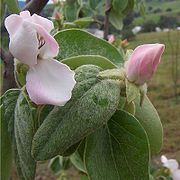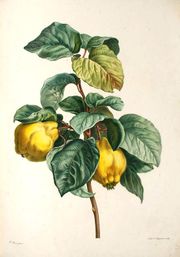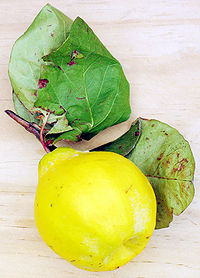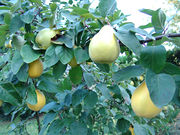Quince
| Quince | |
|---|---|
 |
|
| Cydonia oblonga flowers | |
| Scientific classification | |
| Kingdom: | Plantae |
| Division: | Magnoliophyta |
| Class: | Magnoliopsida |
| Order: | Rosales |
| Family: | Rosaceae |
| Subfamily: | Maloideae or Spiraeoideae[1] |
| Genus: | Cydonia |
| Species: | C. oblonga |
| Binomial name | |
| Cydonia oblonga Mill. |
|


| Nutritional value per 100 g (3.5 oz) | |
|---|---|
| Energy | 238 kJ (57 kcal) |
| Carbohydrates | 15.3 g |
| Sugars | 12.53 g |
| Dietary fiber | 1.9 g |
| Fat | .10 g |
| Protein | .4 g |
| Water | 83.8 g |
| Vitamin A equiv. | 40 μg (4%) |
| Niacin (Vit. B3) | 0.2 mg (1%) |
| Vitamin B6 | 0.04 mg (3%) |
| Folate (Vit. B9) | 8 μg (2%) |
| Vitamin C | 15.0 mg (25%) |
| Calcium | 8 mg (1%) |
| Iron | 0.7 mg (6%) |
| Magnesium | 8 mg (2%) |
| Phosphorus | 17 mg (2%) |
| Potassium | 197 mg (4%) |
| Sodium | 4 mg (0%) |
Quince, raw Percentages are relative to US recommendations for adults. Source: USDA Nutrient database |
|
The quince (pronounced /ˈkwɪns/), or Cydonia oblonga, is the sole member of the genus Cydonia and native to warm-temperate southwest Asia in the Caucasus region. It is a small deciduous tree, growing 5–8 m tall and 4–6 m wide, related to apples and pears, and like them has a pome fruit, which is bright golden yellow when mature, pear-shaped, 7–12 cm long and 6–9 cm broad.
The immature fruit is green with dense grey-white pubescence, most of which rubs off before maturity in late autumn when the fruit changes colour to yellow with hard, strongly perfumed flesh. The leaves are alternately arranged, simple, 6–11 cm long, with an entire margin and densely pubescent with fine white hairs. The flowers, produced in spring after the leaves, are white or pink, 5 cm across, with five petals.
Quince is used as a food plant by the larvae of some Lepidoptera species including Brown-tail, Bucculatrix bechsteinella, Bucculatrix pomifoliella, Coleophora cerasivorella, Coleophora malivorella, Green Pug and Winter Moth.
Four other species previously included in the genus Cydonia are now treated in separate genera. These are the Chinese Quince Pseudocydonia sinensis, a native of China, and the three flowering quinces of eastern Asia in the genus Chaenomeles. Another unrelated fruit, the Bael, is sometimes called the "Bengal Quince".
Turkey ranks first in world quince production by producing a quarter of the total world production.
Contents |
Nomenclature and taxonomy
List of the cultivars
Bereczcki, Champion, Cooke’s Jumbo (Syn. Jumbo), Dwarf Orange, Gamboa, Le Bourgeaut, Lescovacz, Ludovic, Maliformis, Meeches Prolific, Morava, Orange (Syn. Apple quince), Perfume, Pineapple, Portugal (Syn. Lusitanica), Siebosa, Smyrna, Van Deman, Vrajna (Syn. Bereczcki).[2]
Origins
The fruit was known to the Akkadians, who called it supurgillu; Arabic سفرجل safarjal "quinces" (collective plural).[3] The modern name originated in the 14th century as a plural of quoyn, via Old French cooin from Latin cotoneum malum / cydonium malum, ultimately from Greek κυδώνιον μῆλον, kydonion melon "Kydonian apple". The quince tree is native to Iran, Armenia, Azerbaijan, Georgia, Pakistan and was introduced to Syria, Croatia, Bosnia, Turkey, Serbia, Republic of Macedonia, Albania, Greece, Romania, Ukraine and Bulgaria.
Cultivation of quince may have preceded apple culture, and many references translated to "apple", such as the fruit in Song of Solomon, may have been to a quince. Among the ancient Greeks, the quince was a ritual offering at weddings, for it had come from the Levant with Aphrodite and remained sacred to her. Plutarch reports that a Greek bride would nibble a quince to perfume her kiss before entering the bridal chamber, "in order that the first greeting may not be disagreeable nor unpleasant" (Roman Questions 3.65). It was a quince that Paris awarded Aphrodite. It was for a golden quince that Atalanta paused in her race. The Romans also used quinces; the Roman cookbook of Apicius gives recipes for stewing quince with honey, and even combining them, unexpectedly, with leeks. Pliny the Elder mentioned the one variety, Mulvian quince, that could be eaten raw. Columella mentioned three, one of which, the "golden apple" that may have been the paradisal fruit in the Garden of the Hesperides, has donated its name in Italian to the tomato, pomodoro.
Cultivation and uses

Quince is resistant to frost and requires a cold period below 7 °C to flower properly. The tree is self fertile, however yield can benefit from cross fertilization. The fruit can be left on the tree to ripen further which softens the fruit to the point where it can be eaten raw in warmer climates, but should be picked before the first frosts.
Most varieties of quince are too hard, astringent and sour to eat raw unless 'bletted' (softened by frost and subsequent decay). They are used to make jam, jelly and quince pudding, or they may be peeled, then roasted, baked or stewed. The flesh of the fruit turns red after a long cooking time. The very strong perfume means they can be added in small quantities to apple pies and jam to enhance the flavour. Adding a diced quince to apple sauce will enhance the taste of the applesauce with the chunks of relatively firm, tart quince. The term "marmalade", originally meaning a quince jam, derives from "marmelo," the Portuguese word for this fruit.[4][5] The fruit, like so many others, can be used to make a type of wine.
In Iran and other parts of the Middle East, the dried pits of the fruit are used to treat sore throat and to relieve cough. The pits are soaked in water; the viscous product is then drunk like cough medicine. It is commonly used for children, as it is alcohol free and 100% natural. A variety of quince which is grown in the Middle East, does not require cooking and is often eaten raw.
In Europe, quinces are commonly grown in central and southern areas where the summers are sufficiently hot for the fruit to fully ripen. They are not grown in large amounts; typically one or two quince trees are grown in a mixed orchard with several apples and other fruit trees. Charlemagne directed that quinces be planted in well-stocked orchards. Quinces are mentioned for the first time in an English text in the later 13th century, though cultivation in England is not very successful due to inadequate summer heat to ripen the fruit fully. Instead Chaenomeles bushes are grown - their fruit is regarded as a good substitute for quinces and they are known commonly as quinces. Quince juice, Quittensaft, is a common drink in Germany, which is also where the saying "A quince for you, a quince for me, quinces we shall eat" is believed to have originated. In the Balkans and elsewhere quince brandy is made.
In Slavonia, Croatia when a baby is born, quince tree gets planted as a symbol of fertility, love and life.
In Malta, a jam is made from the fruit (ġamm ta' l-isfarġel). According to local tradition, a teaspoon of the jam dissolved in a cup of boiling water relieves intestinal discomfort. In Lebanon, it is called sfarjel and also used to make jam. In Syria, quince is cooked in pomegranate paste (dibs rouman) with shank meat and kibbeh (a middle eastern meat pie with burghul and mince meat) and is called kibbeh safarjalieh. In Iran, quince is called beh (ﺑﻪ) and is used raw or in stews and jam, and the seeds are used as a remedy for pneumonia and lung disease. In parts of Afghanistan, the quince seeds are collected and boiled and then ingested to combat pneumonia. In Pakistan quinces are stewed together with sugar until they turn bright red. The resulting stewed quince, called Muraba is then preserved in jars and eaten like jam.

Quince was also introduced to the New World and also Australia, in temperate states where in some locations it has grown wild, and New Zealand. It has become rare in North America due to its susceptibility to fireblight disease caused by the bacterium Erwinia amylovora. They are still widely grown in Argentina, Chile and Uruguay. Almost all of the quinces in North American specialty markets come from Argentina. In Latin America the gel-like, somewhat adhesive substance surrounding the seeds was used to shape and style hair.
In Argentina, Chile, Mexico, Spain, Uruguay and Venezuela the membrillo, as the quince is called in Spanish, is cooked into a reddish jelly-like block or firm reddish paste known as dulce de membrillo. It is then eaten in sandwiches and with cheese, traditionally manchego cheese, or accompanying fresh curds. In Portugal, a similar sweet is called marmelada. It is also produced and consumed in Hungary where it is called "quince cheese". The sweet and floral notes of carne de membrillo (quince meat) contrast nicely with the tanginess of the cheese.[6] Boiled quince is also popular in desserts such as the murta con membrillo that combines ugni molinae with quince. Similar dish exists in Dalmatia, Croatia.
Used as a rootstock for grafted plants, quince has the property of dwarfing the growth of pears, of forcing them to produce more precociously, and relatively more fruit-bearing branches, instead of vegetative growth, and of accelerating the maturity of the fruit.
In the Canary Islands and some places in South America a quince is used to play an informal beach toss-and-swim game, usually among young teens. When mixed with salt water a mature quince will turn its sour taste to sweet. The game is played by throwing a quince into the sea. All players race to catch the quince and whoever catches it, takes one bite and tosses the quince again, then the whole process gets repeated until the quince is fully eaten.
In the Alsace region of France and the Valais region of Switzerland liqueur de coing is made from quince and used as a digestif.
Quince can also be used as a tea additive to mainly green tea, giving it a rather sweetish taste and scent.
Cultural associations
- Although the book of Genesis does not name the specific type of the fruit that Adam and Eve ate from the tree of knowledge of good and evil in the garden of Eden, some historians and ancient texts suggest that Eve's fruit of temptation might have been a quince.[7]
- The film El Sol del Membrillo (1992) is a documentary about a painter, Antonio López García, who spends September through December painting a quince tree in his garden.
- In Edward Lear's famous poem "The Owl and the Pussycat" the protagonists "dined on mince and slices of quince, Which they ate with a runcible spoon".
- In Plutarch's Lives, Solon is said to have decreed that "bride and bridegroom shall be shut into a chamber, and eat a quince together."[8]
- The quince and quince tree are the main symbol in Carmel Bird's short story "The Quince Tree".
- Popular song by a Bosnian band Indexi is named "Žute dunje" (Yellow Quinces).
- Quince is the closing track on Texan progressive metal band Fair to Midland's album inter.funda.stifle.
Toxicology
As with many related plants, the seeds contain small amounts of hydrogen cyanide. This is only likely to be a problem if they are eaten in bulk.[9]
See also
- List of plants used as medicine
- List of plants poisonous to equines
References
- ↑ Potter, D., et al. (2007). Phylogeny and classification of Rosaceae. Plant Systematics and Evolution. 266(1–2): 5–43.
- ↑ Information from Agroforesty UK
- ↑ Olivier Lauffenburger, 2006. The Hittite Grammar Homepage, Akkadian dictionary, entry for supurgillu
- ↑ Wilson, C. Anne. The Book of Marmalade: Its Antecedents, Its History and Its Role in the World Today (Together with a Collection of Recipes for Marmalades and Marmalade Cookery), University of Pennsylvania Press, Philadelphia. Revised Edition 1999. ISBN 0-8122-1727-6
- ↑ "Marmalade" in Online Etymology Dictionary, © 2001 Douglas Harper apud Dictionary.com
- ↑ Membrillo paste from Gourmet Sleuth
- ↑ Cyclopaedia of Biblical, theological, and ecclesiastical literature, Volume 1 By James Strong
- ↑ Wikisource: Lives by Plutarch, translated by John Dryden: Solon
- ↑ http://www.pfaf.org/database/plants.php?Cydonia+oblonga